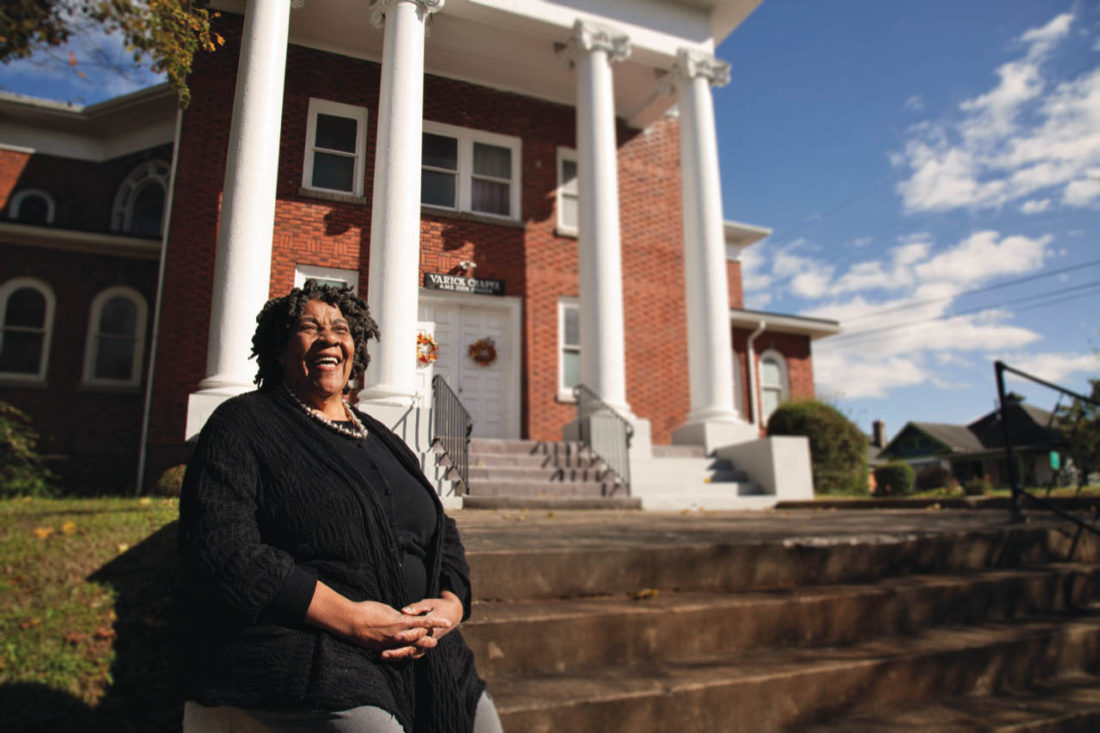Entrepreneur. Philanthropist. Patriarch. Former slave.
James Vester Miller was all of these and more, yet the master brickmason responsible for numerous buildings that defined the look of Asheville in the late 19th and early 20th centuries remains far from a household name.
In an effort to recognize this extraordinary person, Miller’s granddaughter, Andrea Clark, established the James Vester Miller Historic Walking Trail, which officially launches Saturday, June 19, at 1 p.m., at the former Young Men’s Institute Pharmacy on the corner of Eagle and South Market streets.
Family history
A native of Cambridge, Mass., Clark moved to Asheville in the 1960s to connect with her father’s family, who praised the many great deeds of “Pa” Miller. Clark lived with and cared for her 96-year-old cousin, and on Sundays the two would go out to eat and drive around, during which the cousin would point to various buildings and say, “Pa built this,” and “Pa built that.”
At the same time, Clark, who studied photography while in Massachusetts, documented everyday life in the Valley Street neighborhood where she lived, carrying on the tradition of the 1930s Dust Bowl snapshots by Dorothea Lange and Walker Evans. While walking the surrounding East End neighborhood and other parts of Asheville, Clark noticed how buildings and other markers often honored white historical figures but omitted the contributions of Black residents.
“You’ve got Thomas Wolfe, Thomas Wolfe, Thomas Wolfe. But you don’t have any statues of James Vester Miller,” Clark says. “They should have taken [the Vance Monument] and put him on that obelisk. He may have built it anyway.”
Clark explains that Miller collaborated with the structure’s architect, Richard Sharp Smith, on a regular basis; among other projects, the two constructed the YMI and the Asheville Masonic Temple. The Miller & Sons company went on to win many contracts in the white-dominated construction industry, including the Asheville Municipal Building at 100 Court Plaza, which originally housed the city’s police, fire and health departments, and the city jail. Clark eventually got a plaque honoring Miller installed on that building, and with so much of her grandfather’s work within a few blocks, she began thinking about setting up a walking trail with informational printed maps.
True history
Clark got a grant to cover the project’s costs from local giving circle CoThinkk, which invests in the area’s communities of color. She then recruited Anne Callison Stokely from the Wilma Dykeman Legacy to write and edit the text, John Warner to handle photographs and 828:design for the layout. Printing was donated by The Daniels Group.
At the June 19 kickoff, Clark will speak about the endeavor at the YMI, then head to the first structure on the map, St. Matthias Episcopal Church at 1 Dundee St. The church and several other buildings on the nine-stop tour will be open to the public through 4 p.m., part of the robust slate of local activities taking place on the Juneteenth holiday.
The maps also include information on Miller’s plentiful other projects that aren’t on the walking trail. Among them are the old Asheville post office, which was demolished in 1932 when the city’s growth required a larger building and replaced by Pritchard Park; the 1917 front building addition to Haywood Street Church, which now features a fresco depicting Miller and his tools; and the Violet Hill Cemetery in the Emma community of West Asheville, which he was instrumental in founding and where he and other distinguished local Black figures are buried. Emma, where Miller built a 15-room house and raised six children with his wife, Violet, is also home to numerous other residences that he constructed, including several along Brickyard Road.
Eighty-one years after his death, Miller’s granddaughter is working on placing the maps around town, in locations such as the Chamber of Commerce and the LaZoom Room, and doing her part to preserve his legacy.
“Hopefully the history can be told and be told straight,” Clark says. “Somebody said white folks like to have some kind of a written thing. And [with] Black folks, it’s the [spoken] word — we send our history down through the word. But a lot of times, the written statement’s not true.”
As the map notes, “family stories and local tradition” credit Miller “with many buildings for which there is little documentation,” and the complete number of projects in which he or his company were involved will likely never be known. But with Clark’s combination of written and oral historical traditions, Ashevilleans of all backgrounds can gain a greater understanding of Miller’s achievements and an appreciation for one of the city’s lesser-known heroes.
For more information and to download a map, visit avl.mx/9gl.



A wonderful contribution by Andrea Clarke to honoring our history. Thank you for MX for documenting this.
Thank you for opening the eyes and hearts of Ashevillians!